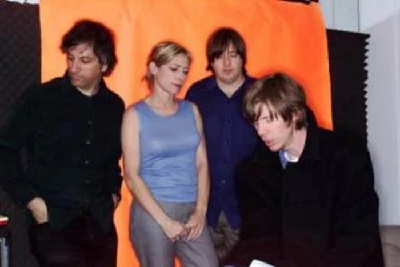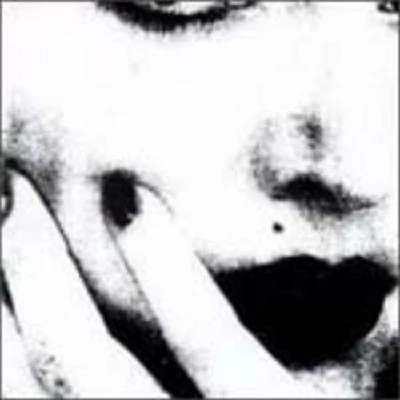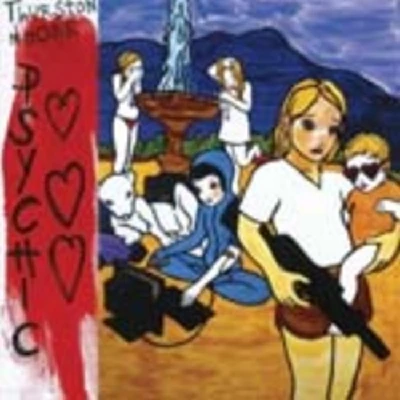published: 18 /
3 /
2006

Mark Rowland assesses the recent reissues of three Sonic Youth-related albums-their self-titled 1982 mini album, side project Ciccone Youth's 1988 album 'The Whitey Album' and Thurston Moore's 1995 solo record 'Psychic Hearts'
Article
The remastered, expanded LP trend marches ever on. A lot of the time, it’s quite irritating; albums you already own re-released with a whole CD’s worth of unreleased tracks, which you buy and soon realise that the tracks were unreleased for a reason.
Occasionally, however, something intriguing is re-released; an album that sold little in its first incarnation and that no-one expected would reappear in record stores again.
Sonic Youth’s first, self-titled EP is one of those, as is their tongue-in-cheek side project, Ciccone Youth’s ‘The Whitey Album’. Although these are unexpected re-releases, however, there are plenty of Sonic Youth fans who don’t have either record, who would buy them basically out of curiosity.
‘Sonic Youth’, initially released at the dawn of the 80's, is unmistakably the same band. The chiming, discordant guitars, Kim Gordon’s breathy, largely spoken word vocals, and Lee Ranaldo’s understated, melodic singing are all present on the record. There are some slight differences however; Thurston Moore’s vocals are much less tuneful (on opener ‘Burning Spear’ he atonally yelps like the guy from the Rapture), original drummer Richard Edson provides a funkier, jittery rhythmic backing and there is a more prominent gamelan influence to the rhythms and sounds the band produced.
Of course, the songs are also much less sophisticated, at times only half-formed. That said, it isn’t an awful record, and it is certainly interesting to listen to the origins of one of the most respected and influential bands in US indie rock. Plus, ‘Burning Spear’ is the infamous early song which features a power drill fed through a wah-wah pedal.
The bonus live set on the disc is a further insight into the origins of the band. Most songs build tension with repetitive, discordant guitar textures and are largely instrumental, very much like ‘Spiderland’-era Slint, but the songs never release the tension they have built by suddenly lurching into a wall of noise; the tension merely builds, then stops. ‘Cosmopolitan Girl’ is one of the more song-based tracks they play, a punky track lead by Kim Gordon’s driving bass and yelled vocals. Early studio recording ‘Where the Red Fern Grows’ is typical of the tense instrumentals they were writing at the time and adds little to the record.
‘The Whitey Album’ offers more strange lo-fi experimentalism, and is obviously a bit of a piss take (track 2, ‘(silence)’, is just over a minute of nothing). It isn’t until track three that anything resembling a song appears; ‘G-Force’, a Kim Gordon spoken word piece over a slow, distant hip hop beat and shimmering, noisy guitars. ‘Platoon II’ also has a deconstructed hip hop sound to it, again haunting atmospherics and blurred beats.
The driving rhythms and distinctive riff of ‘Macbeth’ stands it out from previous tracks, with elements drifting in and out of the mix, giving it an ambient feel at one point, and alt rock feel the next.
‘Burnin’ Up’ is the first actual, fully fledged song on the record, performed in an affectionately mocking way. The remarkably faithful cover of ‘Addicted to Love’ (it is quite possible that Kim Gordon is just singing over a karaoke backing track of the song) is one of the funniest moments on the record; the point when we all get the joke.
It is worth mentioning that ‘The Whitey Album’ was created through a love of pop culture as well as a mockery of it. The album is again interesting rather than essential; an art based experiment deconstructing popular music and culture in the 80s. There is some great elements there; Kim Gordon’s rap ‘Making the Nature Scene’, the ambient textures of ‘Children of Satan/Third Fig’ and the Beastie Boys’ piss-take ‘Tuff Titty Rap’. Their version of Madonna’s ‘Into the Groove(y)’ is also great; an excellent one to throw on at an indie rock party. The song is truly Sonic Youth-ified, slightly lo-fi with the original spliced in occasionally.
Thurston Moore’s solo-record, ‘Psychic Hearts’, kicks off with the offbeat ‘Queen Bee and Her Pals’ which brings to mind Trumans Water. ‘Ono Soul’ is more typically Sonic Youth, with a prominent, dark melody line on guitar and an underlying stream of feedback. The same goes for the title track, which sounds like a more punk rock version of the latter-day Youth. ‘Psychic Hearts' is a lot more song based than the other records, as straight-ahead rock as Moore can be. ‘Patti Smith Math Scratch’ is one of the most rock ‘n’ roll tracks on the record, though it is still built up of several element of noise. ‘See-Through Playmate’ is a nice, upbeat, Pavement-like song that shifts into darker territory at its chorus.
It is certainly the best of the three records, featuring everything that makes Sonic Youth great and hitting the perfect balance between experimentalism and the pop song on most of the tracks. Almost all tracks fall shy of the five-minute mark, which is unusual for Sonic Youth, though Moore makes up for this big style with the 20 minute closer ‘Elegy for Dead Rock Stars’ which for the first five minutes only uses one chord, then changes for a minute, then goes back to one chord. Seven minutes in, and it changes into a sweet yet repetitive guitar line which evolves across the remaining 13 minutes, with a pure noise interlude about two thirds in.
Band Links:-
http://sonicyouth.com/
https://www.facebook.com/sonicyouth/
https://twitter.com/thesonicyouth
Picture Gallery:-


